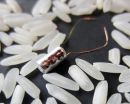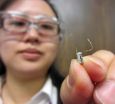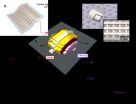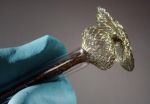(Press-News.org) RICHLAND, Wash. – Scientists have created a microbattery that packs twice the energy compared to current microbatteries used to monitor the movements of salmon through rivers in the Pacific Northwest and around the world.
The battery, a cylinder just slightly larger than a long grain of rice, is certainly not the world's smallest battery, as engineers have created batteries far tinier than the width of a human hair. But those smaller batteries don't hold enough energy to power acoustic fish tags. The new battery is small enough to be injected into an organism and holds much more energy than similar-sized batteries.
Details of the battery, created by scientists at the Department of Energy's Pacific Northwest National Laboratory, were published online recently in Scientific Reports, a member of the Nature collection of journals. Research about the battery's materials was also featured last year in the Journal of Materials Chemistry A.
For scientists tracking the movements of salmon, the lighter battery translates to a smaller transmitter which can be inserted into younger, smaller fish. That would allow scientists to track their welfare earlier in the life cycle, oftentimes in the small streams that are crucial to their beginnings. The new battery also can power signals over longer distances, allowing researchers to track fish further from shore or from dams, or deeper in the water.
"The invention of this battery essentially revolutionizes the biotelemetry world and opens up the study of earlier life stages of salmon in ways that have not been possible before," said M. Brad Eppard, a fisheries biologist with the Portland District of the U.S. Army Corps of Engineers.
"For years the chief limiting factor to creating a smaller transmitter has been the battery size. That hurdle has now been overcome," added Eppard, who manages the Portland District's fisheries research program.
The Corps and other agencies use the information from tags to chart the welfare of endangered fish and to help determine the optimal manner to operate dams. Three years ago the Corps turned to Z. Daniel Deng, a PNNL engineer, to create a smaller transmitter, one small enough to be injected, instead of surgically implanted, into fish. Injection is much less invasive and stressful for the fish, and it's a faster and less costly process.
"This was a major challenge which really consumed us these last three years," said Deng. "There's nothing like this available commercially, that can be injected. Either the batteries are too big, or they don't last long enough to be useful. That's why we had to design our own."
Deng turned to materials science expert Jie Xiao to create the new battery design.
To pack more energy into a small area, Xiao's team improved upon the "jellyroll" technique commonly used to make larger household cylindrical batteries. Xiao's team laid down layers of the battery materials one on top of the other in a process known as lamination, then rolled them up together, similar to how a jellyroll is created. The layers include a separating material sandwiched by a cathode made of carbon fluoride and an anode made of lithium.
The technique allowed her team to increase the area of the electrodes without increasing their thickness or the overall size of the battery. The increased area addresses one of the chief problems when making such a small battery – keeping the impedance, which is a lot like resistance, from getting too high. High impedance occurs when so many electrons are packed into a small place that they don't flow easily or quickly along the routes required in a battery, instead getting in each other's way. The smaller the battery, the bigger the problem.
Using the jellyroll technique allowed Xiao's team to create a larger area for the electrons to interact, reducing impedance so much that the capacity of the material is about double that of traditional microbatteries used in acoustic fish tags.
"It's a bit like flattening wads of Play-Doh, one layer at a time, and then rolling them up together, like a jelly roll," says Xiao. "This allows you to pack more of your active materials into a small space without increasing the resistance."
The new battery is a little more than half the weight of batteries currently used in acoustic fish tags – just 70 milligrams, compared to about 135 milligrams – and measures six millimeters long by three millimeters wide. The battery has an energy density of about 240 watt hours per kilogram, compared to around 100 for commercially available silver oxide button microbatteries.
The battery holds enough energy to send out an acoustic signal strong enough to be useful for fish-tracking studies even in noisy environments such as near large dams. The battery can power a 744-microsecond signal sent every three seconds for about three weeks, or about every five seconds for a month. It's the smallest battery the researchers know of with enough energy capacity to maintain that level of signaling.
The batteries also work better in cold water where salmon often live, sending clearer signals at low temperatures compared to current batteries. That's because their active ingredients are lithium and carbon fluoride, a chemistry that is promising for other applications but has not been common for microbatteries.
Last summer in Xiao's laboratory, scientists Samuel Cartmell and Terence Lozano made by hand more than 1,000 of the rice-sized batteries. It's a painstaking process, cutting and forming tiny snippets of sophisticated materials, putting them through a flattening device that resembles a pasta maker, binding them together, and rolling them by hand into tiny capsules. Their skilled hands rival those of surgeons, working not with tissue but with sensitive electronic materials.
A PNNL team led by Deng surgically implanted 700 of the tags into salmon in a field trial in the Snake River last summer. Preliminary results show that the tags performed extremely well. The results of that study and more details about the smaller, enhanced fish tags equipped with the new microbattery will come out in a forthcoming publication. Battelle, which operates PNNL, has applied for a patent on the technology.
INFORMATION:
In addition to Xiao, Deng, Cartmell and Lozano, other authors of the paper include Honghao Chen, Qiang Wang, Huidong Xi, Xilin Chen, Yong Yuan, Mark Gross, and Thomas Carlson.
Reference: Honghao Chen, Samuel Cartmell, Qiang Wang, Terence Lozano, Z. Daniel Deng, Huidong Li, Xilin Chen, Yong Yuan, Mark E. Gross, Thomas J. Carlson and Jie Xiao, Micro-battery development for juvenile salmon acoustic telemetry system applications, Scientific Reports, Jan. 21, 2014, http://dx.doi.org/10.1038/srep03790.
A battery small enough to be injected, energetic enough to track salmon
Device stores twice the energy of microbatteries currently used in transmitters
2014-02-18
ELSE PRESS RELEASES FROM THIS DATE:
Controlling magnetism with an electric field
2014-02-18
Coral Gables, Fla. (Feb. 17, 2014) -- There is a big effort in industry to produce electrical devices with more and faster memory and logic. Magnetic memory elements, such as in a hard drive, and in the future in what is called MRAM (magnetic random access memory), use electrical currents to encode information. However, the heat which is generated is a significant problem, since it limits the density of devices and hence the performance of computer chips.
Scientists are now proposing a novel approach to achieve greater memory density while producing less heat: by using ...
University of Illinois study of 2011 flood will lead to better preparedness
2014-02-18
In May 2011, when the U.S. Army Corps of Engineers used explosives to breach a levee south of Cairo, Ill., diverting the rising waters of the Mississippi and Ohio rivers to prevent flooding in the town, about 130,000 acres of Missouri farmland were inundated. It was the largest flood of the lower Mississippi ever recorded, and researchers from the University of Illinois at Urbana-Champaign took advantage of this "once-in-a-scientific-lifetime" occurrence to study the damage, funded by a National Science Foundation Rapid Response Grant. Their results, published this week ...
Embarking on geoengineering, then stopping, would speed up global warming
2014-02-18
Spraying reflective particles into the atmosphere to reflect sunlight and then stopping it could exacerbate the problem of climate change, according to new research by atmospheric scientists at the University of Washington.
Carrying out geoengineering for several decades and then stopping would cause warming at a rate that will greatly exceed that expected due to global warming, according to a study published Feb. 18 in Environmental Research Letters.
"The absolute temperature ends up being roughly the same as what it would have been, but the rate of change is so drastic, ...
In fight against teen prescription drug abuse, one-two punch wins
2014-02-18
DURHAM, N.C. -- Programs that aim to curb teen prescription drug abuse have vastly differing effectiveness, ranging from big drops in drug abuse to no measurable effect, according to a new study of 11,000 teenagers by researchers at Duke and Pennsylvania State universities.
The best results came from pairing a school-based program with a home-based intervention, resulting in a 10 percent decrease in abuse rates. By contrast, most school-based programs were ineffective when used by themselves, with just one exception.
The six-year study is among the first to measure ...
Research team establishes benchmark set of human genotypes for sequencing
2014-02-18
Led by biomedical engineer Justin Zook of the National Institute of Standards and Technology, a team of scientists from Harvard University and the Virginia Bioinformatics Institute of Virginia Tech has presented new methods to integrate data from different sequencing platforms, thus producing a reliable set of genotypes to benchmark human genome sequencing.
"Understanding the human genome is an immensely complex task and we need great methods to guide this research," Zook says. "By establishing reference materials and gold standard data sets, scientists are one step closer ...
Smartphone app aids college-age women in abusive relationships
2014-02-18
COLUMBIA, Mo. –Women between the ages of 18 and 24 are at the highest risk for dating violence, according to the Centers for Disease Control and Prevention. However, these women are less likely than older adults to seek formal safety resources and instead look to peers or technology for help and advice. In an effort to connect more young women with safety information, University of Missouri researchers collaborated with Johns Hopkins University School of Nursing and the One Love Foundation to develop the "One Love My Plan" smartphone application, an interactive tool that ...
Breakthrough development of flexible 1D-1R memory cell array
2014-02-18
With the introduction of curved smartphones, flexible electronic goods are gradually moving to the center stages of various markets. Flexible display technology is the culmination of the latest, cutting-edge electric cell device technology. Developing such products, however, requires not only a curved display, but also operational precision of other parts, including the memory, in a flexible state.
Dr. Tae-Wook Kim at KIST announced their successful development of a 64-bit memory array using flexible and twistable carbon nano material and organo-polymer compound, which ...
Medicare beneficiaries return to emergency rooms after nursing home discharge
2014-02-18
Nursing homes are widely used by Medicare beneficiaries who require rehabilitation after hospital stays. But according to a recent study led by a researcher at the University of North Carolina at Chapel Hill School of Nursing, a high percentage of Medicare patients who are discharged from nursing homes will return to the hospital or the emergency room within 30 days.
"Nearly two million older adults use this benefit every year," said assistant professor Mark Toles, the first author of the study. "Before this study, we didn't recognize the large number of older adults ...
Healthy Lunchbox Challenge helps influence healthy eating habits in children
2014-02-18
AUDIO:
Falon Tilley and Michael W. Beets discuss the successful implementation of the Healthy Lunchbox Challenge, an innovative theory and incentive-based program, at four large-scale, community-based summer day camps. They observed...
Click here for more information.
PHILADELPHIA, PA, February 18, 2014 – During the school year, 21 million children receive free or reduced-price lunches, yet less than 10% of those children participate in the Department of Agriculture's Summer ...
Metal in the heart is non-hazardous to health
2014-02-18
Jena (Germany) A trousers button, a coin or a watch can be dangerous for people with a nickel allergy. Approximately 1 in 10 Germans is allergic to the metal. "This raises the question of the safety of medical implants containing nickel," explains Professor Dr. Markus Rettenmayr of the Friedrich Schiller University Jena (Germany). Nickel-titanium alloys are increasingly used as material for cardiovascular implants in minimal invasive surgery. Once implanted, nickel-titanium alloys can release small amounts of nickel due to corrosion phenomena, the holder of the Chair of ...
LAST 30 PRESS RELEASES:
Tracing the quick synthesis of an industrially important catalyst
New software sheds light on cancer’s hidden genetic networks
UT Health San Antonio awarded $3 million in CPRIT grants to bolster cancer research and prevention efforts in South Texas
Third symposium spotlights global challenge of new contaminants in China’s fight against pollution
From straw to soil harmony: International team reveals how biochar supercharges carbon-smart farming
Myeloma: How AI is redrawing the map of cancer care
Manhattan E. Charurat, Ph.D., MHS invested as the Homer and Martha Gudelsky Distinguished Professor in Medicine at the University of Maryland School of Medicine
Insilico Medicine’s Pharma.AI Q4 Winter Launch Recap: Revolutionizing drug discovery with cutting-edge AI innovations, accelerating the path to pharmaceutical superintelligence
Nanoplastics have diet-dependent impacts on digestive system health
Brain neuron death occurs throughout life and increases with age, a natural human protein drug may halt neuron death in Alzheimer’s disease
SPIE and CLP announce the recipients of the 2025 Advanced Photonics Young Innovator Award
Lessons from the Caldor Fire’s Christmas Valley ‘Miracle’
Ant societies rose by trading individual protection for collective power
Research reveals how ancient viral DNA shapes early embryonic development
A molecular gatekeeper that controls protein synthesis
New ‘cloaking device’ concept to shield sensitive tech from magnetic fields
Researchers show impact of mountain building and climate change on alpine biodiversity
Study models the transition from Neanderthals to modern humans in Europe
University of Phoenix College of Doctoral Studies releases white paper on AI-driven skilling to reduce burnout and restore worker autonomy
AIs fail at the game of visual “telephone”
The levers for a sustainable food system
Potential changes in US homelessness by ending federal support for housing first programs
Vulnerability of large language models to prompt injection when providing medical advice
Researchers develop new system for high-energy-density, long-life, multi-electron transfer bromine-based flow batteries
Ending federal support for housing first programs could increase U.S. homelessness by 5% in one year, new JAMA study finds
New research uncovers molecular ‘safety switch’ shielding cancers from immune attack
Bacteria resisting viral infection can still sink carbon to ocean floor
Younger biological age may increase depression risk in older women during COVID-19
Bharat Innovates 2026 National Basecamp Showcases India’s Most Promising Deep-Tech Ventures
Here’s what determines whether your income level rises or falls
[Press-News.org] A battery small enough to be injected, energetic enough to track salmonDevice stores twice the energy of microbatteries currently used in transmitters







